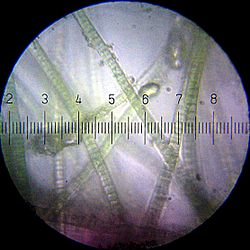
Back Sianobakterie Afrikaans ሰማያዊ አረንጓዴአማ ዋቅላሚዎች Amharic Cyanobacteria AN بكتيريا زرقاء Arabic بكتيريا زرقاء ARZ Sianobakteriya Azerbaijani Цыянабактэрыі Byelorussian Цианобактерии Bulgarian সায়ানোব্যাকটেরিয়া Bengali/Bangla Cijanobakterije BS
| Cyanobacteria Temporal range: 3500 mya – Recent
| |
|---|---|

| |
| Oscillatoria sp | |
| Scientific classification | |
| Domain: | |
| Phylum: | Cyanobacteria
|
| Orders | |
|
The taxonomy is under revision[1][2]
| |



Cyanobacteria are a taxon of bacteria which conduct photosynthesis. They are not algae, though they were once called blue-green algae. It is a phylum of bacteria, with about 1500 species. In endosymbiont theory, chloroplasts (plastids) are descended from cyanobacteria. Their DNA profile is evidence for this.[3][4][5]
Cyanobacteria have an extremely long fossil record, starting at least 3,500 million years ago. They were the main organisms in the stromatolites of the Archaean and Proterozoic eons.[6]
The ability of cyanobacteria to perform oxygenic photosynthesis is highly significant. The early atmosphere on Earth was largely reducing, that is, without oxygen. The cyanobacteria in stromatolites were the first known organisms to photosynthesise and produce free oxygen. After about a billion years, the effect of this photosynthesis began a huge change in the atmosphere. The process, called the Great Oxygenation Event, took a long time. Eventually, it killed off most of the organisms which could not live in oxygen, and led to the kinds of environment we know today, where most organisms use and need oxygen.[7][8]
- ↑ "Cyanophyceae". Access Science. doi:10.1036/1097-8542.175300. Retrieved 21 April 2011.
{{cite journal}}: Cite journal requires|journal=(help) - ↑ Ahoren Oren (2004). "A proposal for further integration of the cyanobacteria under the Bacteriological Code". Int. J. Syst. Evol. Microbiol. 54 (Pt 5): 1895–1902. doi:10.1099/ijs.0.03008-0. PMID 15388760.
- ↑ Sapp J. 1994. Evolution by association: a history of symbiosis. Oxford.
- ↑ Giovannoni S.J. et al 1988. Evolutionary relationships among cyanobacteria and green chloroplasts. J Bacteriol. 170: 3584–3592.
- ↑ Gupta, Radhey S. et al 2003. Molecular signatures in protein sequences that are characteristic of cyanobacteria and plastidhomologues. International Journal of Systematic and Evolutionary Microbiology. 53, 1833-1842. Gupta, R[permanent dead link]
- ↑ Knoll, Andrew H. 2004. Life on a young planet: the first three billion years of evolution on Earth. Princeton, N.J. ISBN 0-691-12029-3
- ↑ Frei R. et al 2009. Fluctuations in Precambrian atmospheric oxygenation recorded by chromium isotopes. Nature 461 (7261): 250–253. Abstract: [1]
- ↑ Holland, Heinrich D. 2006. The oxygenation of the atmosphere and oceans. Phil. Trans. R. Soc. B, 361, p. 903–915. [2]